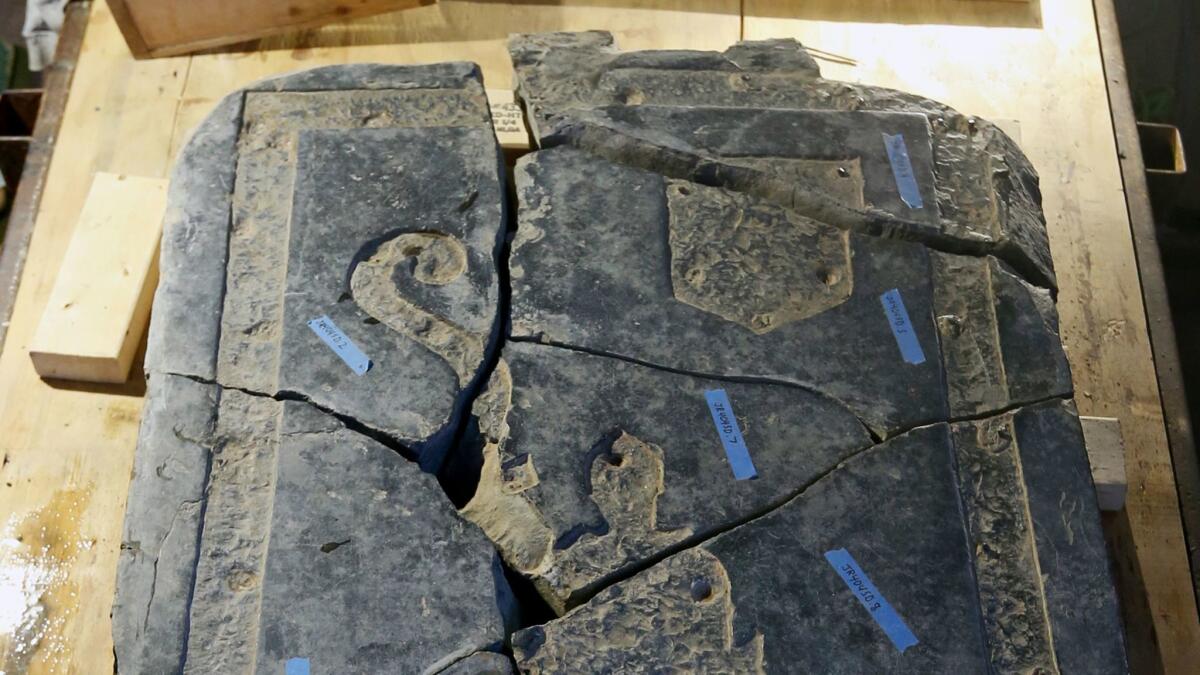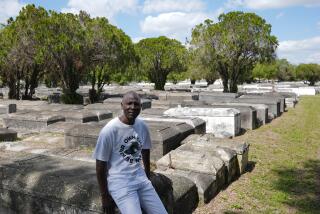Saving a one-of-a-kind gravestone, a piece of an archaeological puzzle at historic Jamestown

Six months after launching a painstaking probe aimed at English America’s second-oldest church, Jamestown archaeologists have unearthed a jumbled historical puzzle that reaches back 400 years.
First, there are the fractured layers of brick pavers and floor tiles laid during construction of three sanctuaries in 1617, the 1640s and the 1680s — and then covered again by Jamestown Memorial Church in 1906.
Then there’s the mystery of the mammoth, 1,200-pound burial stone that may date to the 1620s — making it the oldest of its kind in the country — and which conservators only recently rescued from the potentially destructive Portland cement that bound it to the 1906 floor.
Complicating this already cryptic complex of archaeological evidence is a late-18th-century cemetery wall that cuts diagonally across the footprints of all three 1600s churches — yet which is made of bricks robbed from their ruinous floors and walls.
Generations of brown-stained grave shafts dapple the ground here, too, including some so ancient they have been visibly compressed or cut through by all the building and burials that followed.
“All these jumbled-up layers — all these cut-throughs — are really challenging, and it’s making us do some real archaeology,” says William M. Kelso, director of James Rediscovery, a group dedicated to studying the rich history of the first permanent English settlement in North America.
“But there’s virtually no documentation about this church — where the first legislative assembly met in 1619 — and we want to be as ready as we can to interpret it when the 400th anniversary comes in 2019,” he says.
First excavated by the founders of the Assn. for the Preservation of Virginia Antiquities — now known as Preservation Virginia — in the early 1900s, the site of the 1617, 1640s and 1680s churches has been the target of a comprehensive reinvestigation for nearly two years.
Beginning outside the walls of the 1906 church, the archaeologists sifted through evidence of all three building campaigns as well as the antiquities group’s pioneering efforts to dig for signs of the historic 1617 church. Since last fall, they’ve carried out the same tedious kind of excavation inside the 1906 structure.
Among the artifacts missed by the early-1900s digs is a wooden doublet button covered with silver thread — a good indicator of the owner’s high status, says senior archaeologist Mary Anna Hartley, who is leading the excavation team.
Then there’s the silver Spanish coin found under the black slab of stone that — because of the shield and armored figure carved across its face — is known as “the Knight’s Tomb.”
“This was the common currency of the time, and it was probably someone’s tithe accidentally dropped in the aisle of the church,” Hartley says. “It’s dated 1664, and that could be a clue to when the stone was moved.”
In addition to the remaining expanse under the 1906 floor, the targets include the elusive grave that some past remodeling campaign separated from the ledger stone long ago. Cemented into the floor of the 1906 church, the black ledger stone has puzzled historians and archaeologists for generations, senior conservator Michael Lavin says.
Originally emblazoned with an inscribed metal plaque as well as the shield and knight’s figure, it was stripped of these vital clues centuries ago, leaving the identity of the remains it marked a puzzle. It also was moved from its initial location, then placed back in the floor with a north-south alignment that completely defies the English church’s east-west burial traditions.

Still, no one failed to recognize the unusually high status indicated by the elaborate way the stone was carved and then inlaid with metal figures and borders.
That’s one reason why Lavin decided to bring in a consulting conservator to deal with the fractures as well as the potential problems caused by the ring of rigid Portland cement that surrounded the marker.
With nearly 20 years’ experience conserving historic gravestones and monuments — plus a dozen years of preservation work before that — Connecticut-based Jonathan Appell knew right away that the Jamestown stone was a stand-out example.
Though he’s worked on some of the oldest gravestones in America, Appell had never seen an inlaid marker from the 1600s.
“Almost everything about it — especially the inlay — is unusual,” he says. “It’s very detailed and involved — and you can still see some of the pins that fastened the inlay to the stone. Obviously, it was meant to mark the grave of someone very wealthy.”
Among the challenges was the problem of lifting the fractured 1,200-pound artifact from the floor and moving it to a welded-steel work table. The challenge was getting the big piece up without a crane or mechanical equipment. “But with a ramp and a few strong individuals, we were able to move it,” Appell says.
Once freed from the Portland cement that bound them together, the half-dozen fragments will be dry-fitted and squared as tightly as possible, then clamped and rejoined with a stone epoxy before being reinstalled sometime before 2019.
All the work is being carried out inside the 1906 church, adding to the spectacle of the constantly expanding sub-floor excavation that has attracted a steady stream of tourists.
At the project’s nearby curatorial and conservation lab, another facet of the investigation has uncovered new evidence that finally may solve the puzzle surrounding the identity of the remains once marked by the ledger stone.
Though one of the mostly likely candidates is first Virginia Gov. Lord De La Warr — who died at sea in 1618 and is believed to have been buried at Jamestown shortly afterward — a will from the 1600s unearthed in March may point to one of his successors.
Related to Sir George Yeardley by adoption and marriage, Adam Thoroughgood II identified strongly with the wealthy Jamestown planter and three-time governor, assistant curator Hayden Bassett says. And he asked that his own gravestone be marked with both the Yeardley coat of arms and an inscription matching that found on what he describes as “the broken tomb.”
“We think that could be the stone we have here,” Bassett says, “and the family tradition of marking its graves with black marble gives us even more reason to think so.”
Six years before his death in 1625, Yeardley played a key role in the church’s history, presiding over the historic first assembly.
That would make finding his remains and a positive link to the ledger stone particularly fitting.
“It could be the smoking gun we’ve been looking for,” Lavin says. “But there’s a lot of work to be done before we can prove it.”
Erickson writes for the Daily Press in Newport News, Va.
More to Read
Start your day right
Sign up for Essential California for news, features and recommendations from the L.A. Times and beyond in your inbox six days a week.
You may occasionally receive promotional content from the Los Angeles Times.






